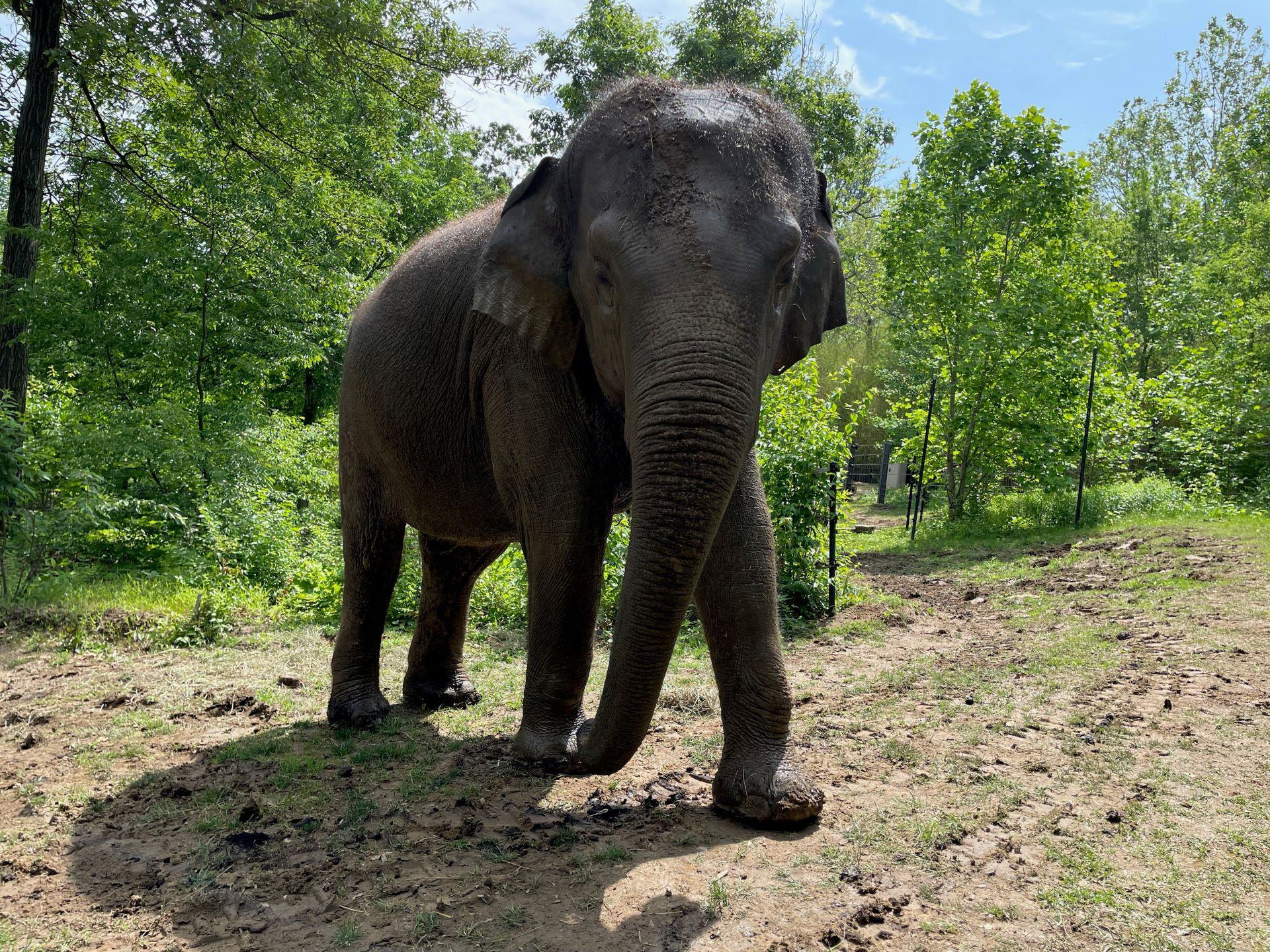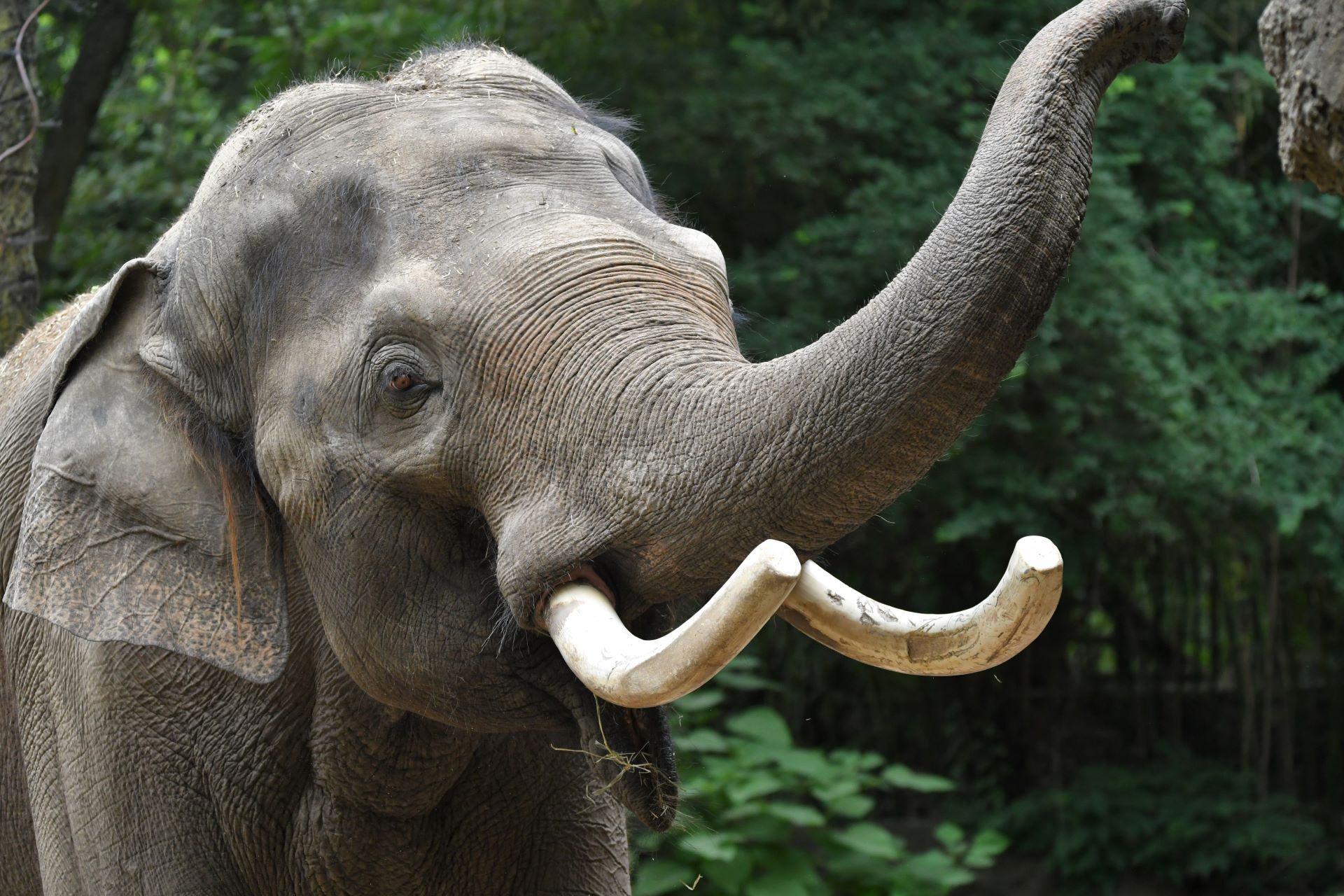Big New Adventures for Asian Elephants Raja and Jade
- Raja, the male Asian elephant at the Saint Louis Zoo, will move to the Columbus Zoo and Aquarium. The planned move, still likely a year or more away, is based on recommendations from the Association of Zoos and Aquariums Asian Elephant Species Survival Plan; important in the effort to help save the species from extinction.
- Jade is pregnant with her first calf; a Saint Louis Zoo first with elephant artificial insemination
St. Louis, Mo (Dec. 14, 2023) He was the first elephant ever born at the Saint Louis Zoo and is considered a St. Louis legend. Male Asian elephant Raja, born amid fanfare nearly 31 years ago on Dec. 27, 1992, has three daughters at the Zoo and will soon move from St. Louis to start another elephant family, in an effort to help save the species from extinction.
“This news is bittersweet for all of us. We know Raja is dear to his fans and to the Zoo family and he’ll be missed here, but we know this is for the best for Raja and the survival of this species,” said Michael Macek, Saint Louis Zoo Director. “Thirty years of birthday celebrations is something that will live on in everyone’s memories.”
The plan is for Raja to join Asian elephants at the Columbus Zoo and Aquarium where he will have the opportunity to bond with four females and form a new family group and mentor a young male. This move is recommended by the Association of Zoos and Aquariums (AZA) Asian Elephant Species Survival Plan (SSP). This program works in cooperation with other institutions accredited by the AZA to manage the Asian elephant population in North America and maximize their health, wellbeing and genetic diversity.
Moves such as this closely mirror the natural behaviors of wild elephants, according to Macek. Adult males live solo or together in small bachelor herds, while females raise their calves and live in multi-generational family groups. Males find females to breed and then move on.
“Raja moving to Columbus provides an environment where he and others can naturally grow their families, which is an important component to their wellbeing,” said Macek. “We’re glad we can give him this opportunity.”
Raja’s move is likely to take place in late 2024 or early 2025. Once he is settled in at his new home, the Zoo would have room to welcome another male at River’s Edge, and the SSP has provisionally identified Samudra, a 15-year-old from Oregon, as a good match for our female herd.
“Samudra has reached the age where wild male elephants naturally move away from the herd they were raised in,” said Bob Lee, AZA Asian Elephant SSP Coordinator. “The timing could be right for him, and this would be an amazing opportunity for Samudra to meet and mingle with a different female herd.”
Lee emphasized that SSP plans and recommendations can change as new situations arise.
“Obviously, nothing is certain when you’re planning this far in advance and with so many variables,” he said. “But Asian elephants are facing a serious threat of extinction right now, and we need to be thinking ahead like this to ensure their survival into the future.”
Jade’s Pregnancy
Raja’s second daughter, Jade, nearly 17, is 10 months pregnant with her first calf and due to give birth in late 2024 or early 2025. The calf will be the first born at the Saint Louis Zoo through artificial insemination. The father is Jake, who was born at African Lion Safari in Ontario, Canada and currently lives at Denver Zoo. This birth will begin the fourth generation of Asian elephants at the Zoo.
“We’re looking forward to the new calf joining our multi-generational elephant family, and we’re optimistic that everything will go well for Jade,” said Tim Thier, Curator of Mammals/Ungulates and River’s Edge. “Our experienced, professional Animal Care team is providing exceptional care for Jade during her pregnancy, including customized exercise and birth plans,” said Thier.
An elephant pregnancy lasts about 22 months and a newborn weighs about 250-350 pounds. Jade receives regular prenatal health checkups by the Zoo’s Animal Care and Animal Health teams. At this time, the sex of the calf is unknown.
The Saint Louis Zoo is committed to improving the sustainability of the Asian elephant population. Using the science of artificial insemination allowed Jade to contribute to the sustainability of the population while remaining with her family group.
Multi-Generational Elephant Family at the Zoo
River’s Edge at the Saint Louis Zoo is home to a seven-member, three-generation family of Asian elephants:
- Raja, 30: Father to Maliha, Jade and Priya
- Pearl, 52: Mother to Raja
- Ellie, 52: Mother to Maliha and Priya; grandmother to Jade
- Sri (pronounced “See), 43: Unrelated “auntie” to Priya, Maliha and Jade
- Maliha, 17: Ellie and Raja’s daughter (born August 2006)
- Jade, 16: Raja’s daughter (born February 2007)
- Priya 10: Ellie and Raja’s daughter (born April 2013)
“All elephants have access to spacious, natural and diverse habitats at River’s Edge. They receive nutritious food and specialized health care. They also receive dynamic daily enrichment items that promote positive mental and physical activity and stimulate natural behaviors. Breeding and calf rearing is one important part of our robust, multi-faceted animal wellbeing program, and important to the elephants’ social structure,” said Regina Mossotti, Vice President of Animal Care, Saint Louis Zoo.
“We know from research studies that elephants’ welfare improves when they live in a family with calves. We are proud to continue fostering a robust family dynamic for our elephants,” said Mossotti.
See Raja and Elephant Family
“We encourage guests to come to see Raja and his elephant family. The move likely won’t happen for at least a year. A visit to the Zoo not only inspires guests to care about elephants and take actions to protect and conserve them, but a majority of guests who visit the Zoo learn something new that they retain and are able to share with others, empowering future conservation leaders,” said Macek.
“A visit to an AZA-accredited zoo or aquarium, like the Saint Louis Zoo, is the way most people have the privilege to experience the majesty of elephants and other wildlife from around the world. That experience and the connection to nature that it provides is increasingly vital to inspiring personal and collective commitment to conservation of wildlife and wild places,” said Dan Ashe, president and CEO of AZA. “Our accredited members create these experiences while also providing the highest standard of care, focused on the overall wellbeing of the animals, including science-based health and nutrition and meeting their social and emotional needs.”
Asian Elephant Conservation
There are less than 50,000 Asian elephants left in the wild, and they are facing extinction due to habitat loss and poaching. Given the shrinking population of Asian elephants, the Saint Louis Zoo is committed to conserving this endangered species. The Saint Louis Zoo WildCare Institute Center for Asian Elephant Conservation supports the welfare and conservation of Asian elephants in Sumatra and other countries in Indonesia, India and Laos. The Saint Louis Zoo WildCare Institute Center for Conservation in the Horn of Africa also supports conservation of African elephants in Kenya through the Northern Rangelands Trust.
The North American population of Asian elephants acts as an assurance population for their wild counterparts, to help ensure the future of this important species.
About the Saint Louis Zoo
Home to over 16,000 animals, representing nearly 500 species, the Saint Louis Zoo is recognized worldwide for its innovative approaches to animal care and management, wildlife conservation, research, and education. One of the few free zoos in the nation, the Saint Louis Zoo is the most-visited attraction in the region. Accredited by the Association of Zoos and Aquariums (AZA), the Saint Louis Zoo is part of an elite group of institutions that meet the highest standards in animal care as well as provide fun, safe and educational family experiences. The Saint Louis Zoo and the other AZA-accredited institutions collectively dedicate millions of dollars annually to support scientific research, conservation and education programs. For more information, visit stlzoo.org.
###



